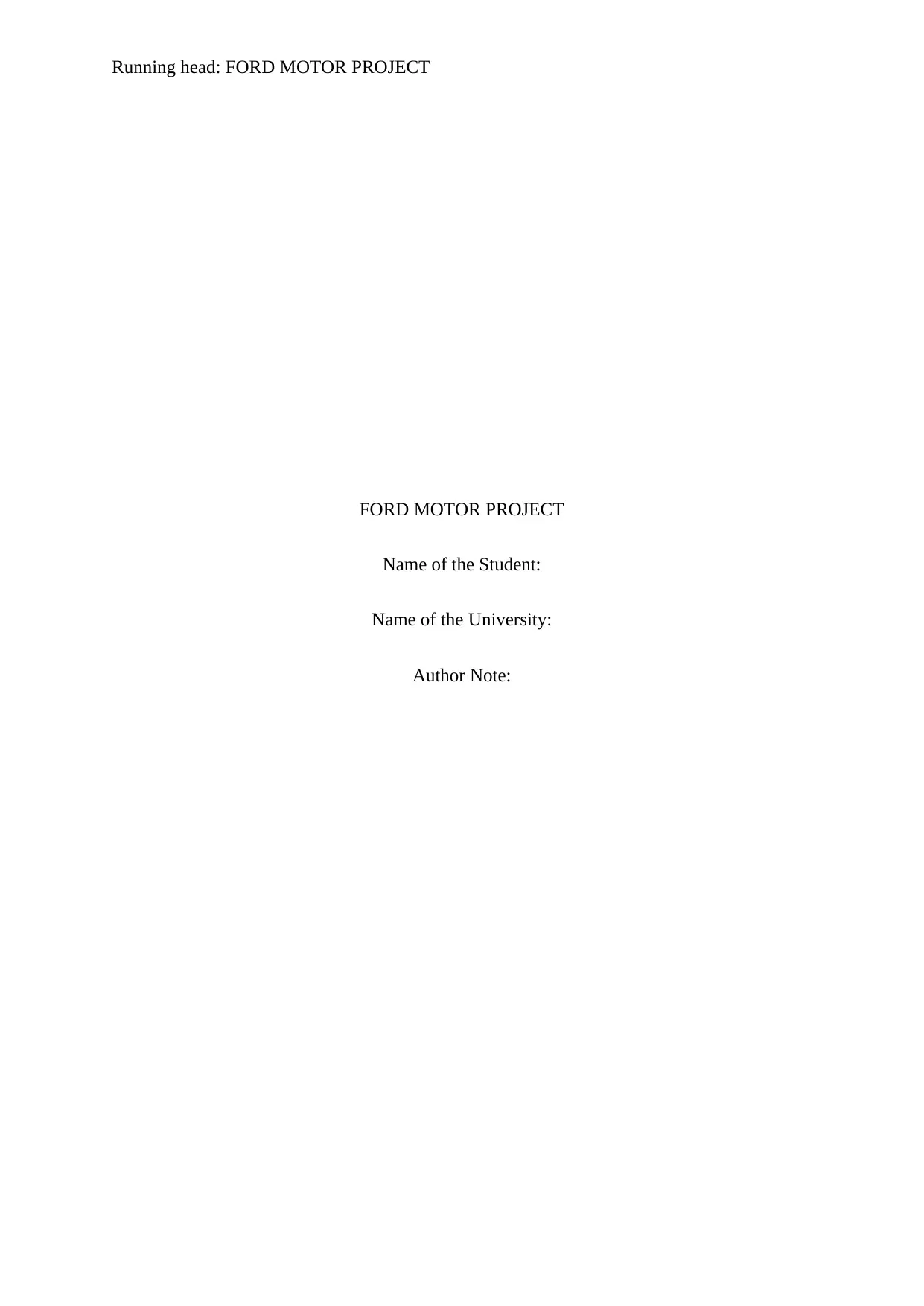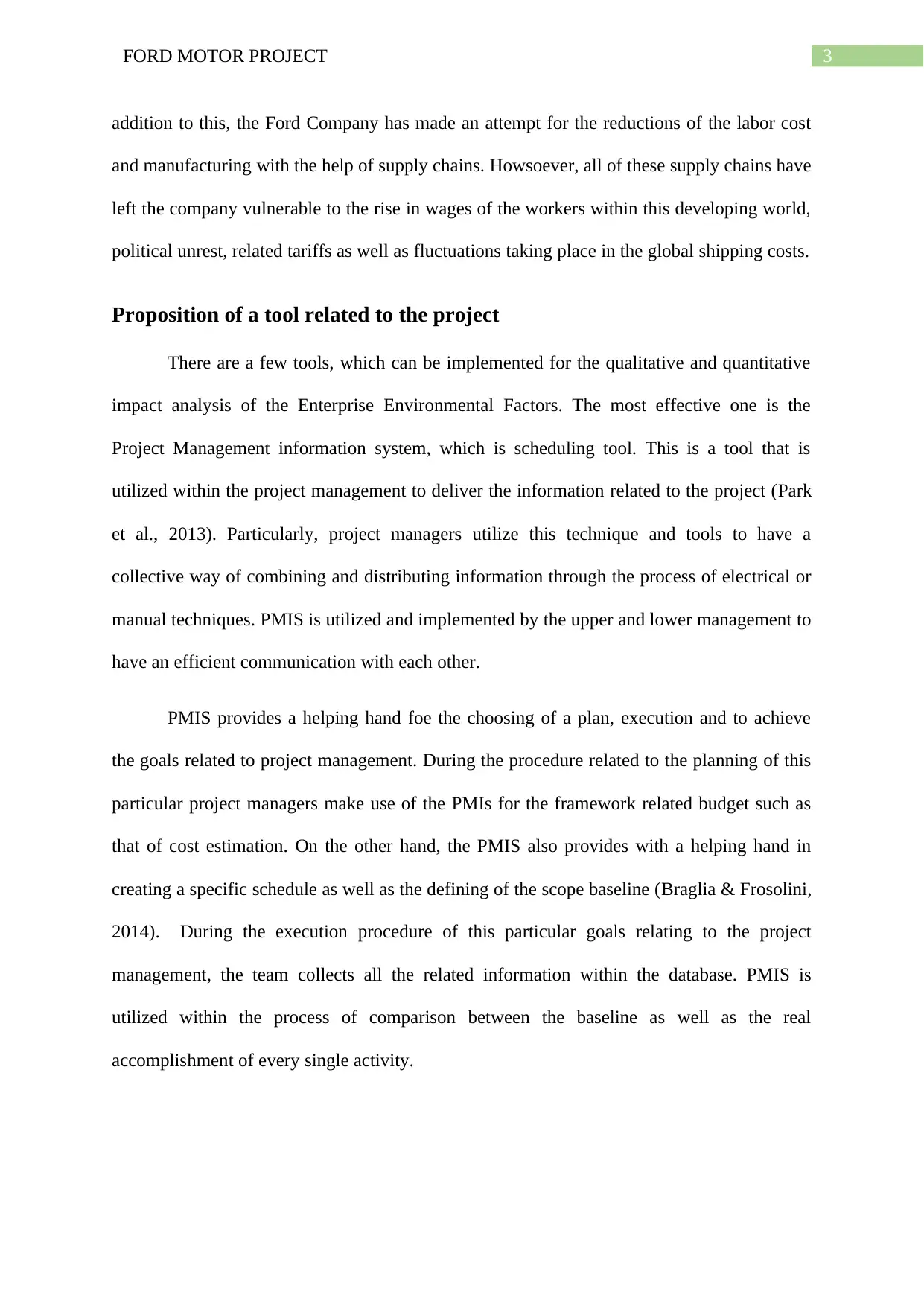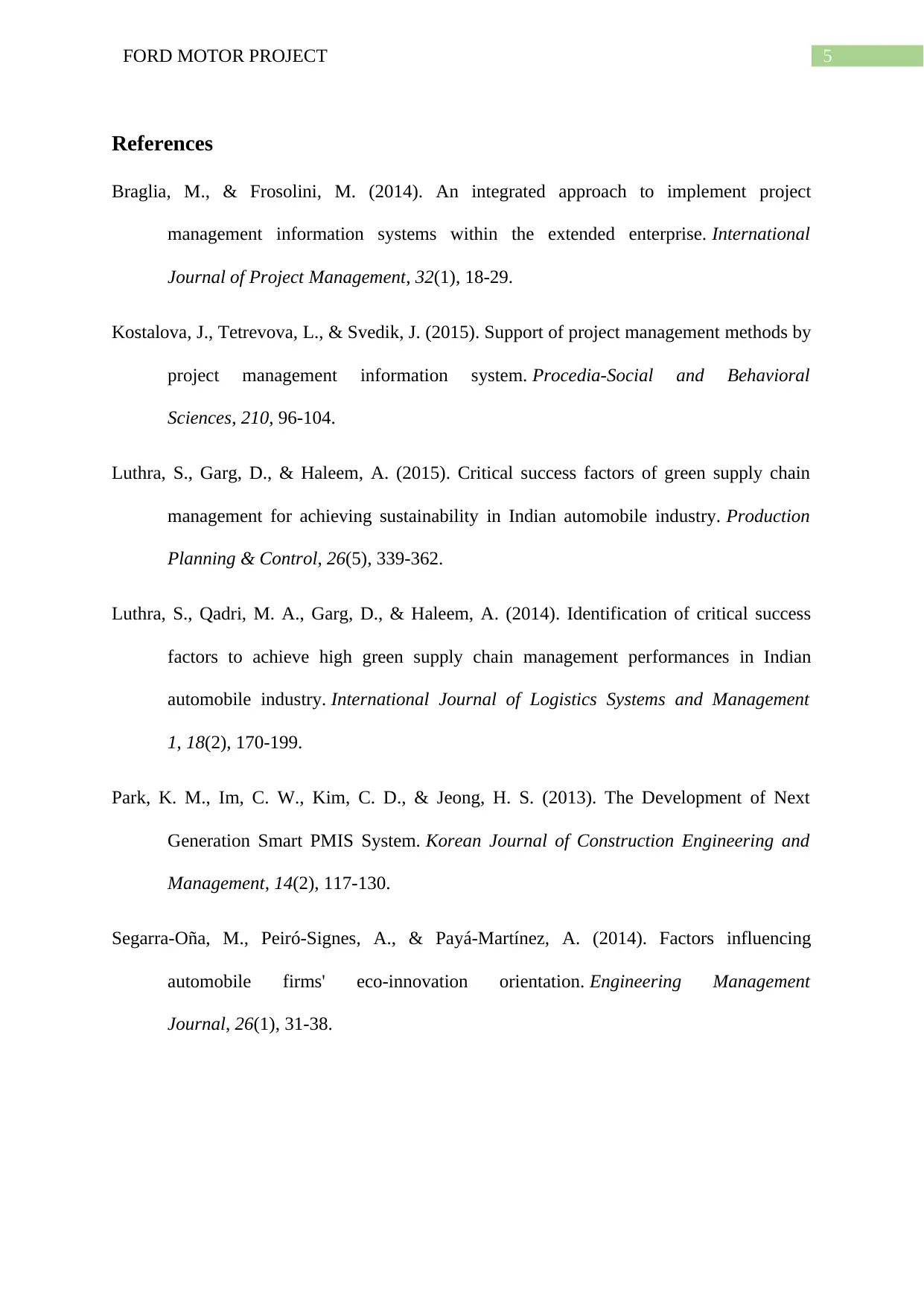PROJ6001 - Ford Motor Project: Impact of EEF and PMIS Analysis Report
VerifiedAdded on 2022/10/10
|6
|1099
|218
Report
AI Summary
This report examines the Enterprise Environmental Factors (EEF) influencing the Ford Motor Project, including external factors like infrastructure, fuel prices, economic conditions, and currency fluctuations. The report highlights how these factors can affect the company's profitability and sales. The report proposes the Project Management Information System (PMIS) as a valuable tool for analyzing the qualitative and quantitative impact of EEFs. PMIS is justified for its ability to collect, organize, and disseminate project-related data, aiding in scope determination and progress tracking. The report references several academic sources to support its analysis and recommendations, demonstrating a comprehensive understanding of the interplay between EEFs, project management, and the automotive industry. The report details the use of PMIS for project planning, execution, and comparison of baseline and actual performance.

Running head: FORD MOTOR PROJECT
FORD MOTOR PROJECT
Name of the Student:
Name of the University:
Author Note:
FORD MOTOR PROJECT
Name of the Student:
Name of the University:
Author Note:
Paraphrase This Document
Need a fresh take? Get an instant paraphrase of this document with our AI Paraphraser

1FORD MOTOR PROJECT
Table of Contents
Identification of EEF of the project...........................................................................................2
Proposition of a tool related to the project.................................................................................3
Justification of the tool selected.................................................................................................3
References..................................................................................................................................5
Table of Contents
Identification of EEF of the project...........................................................................................2
Proposition of a tool related to the project.................................................................................3
Justification of the tool selected.................................................................................................3
References..................................................................................................................................5

2FORD MOTOR PROJECT
Identification of EEF of the project
Enterprise Environmental Factors refer to either internal or external factors, which can
affect the project in any way possible influencing the success of the project (Segarra-Oña,
Peiró-Signes & Payá-Martínez, 2014). These factors include the likes of culture, conditions
of the weather, regulations imposed by the government, situation of the politics and market
conditions.
The term commonly referred to as EEF that highlight the elements outside the
industry, which are generally the important part of the concern relating to the profitability of
the Ford Motor Company.
Firstly, the Ford Motor Company is massively dependent upon the infrastructure
including the likes of investment done upon the roads as well as the existence of a wide
network of stations delivering fuel (Luthra, Garg & Haleem, 2015). However, if the countries
decide to make more investments within the sector of public transit and withdraw the already
made investments upon the road networks leading to a fact that the general public buy a lot
fewer works.
Next, the cars which provide the majority of the profit to the Ford Motor have a
tendency to be inefficient due to the larger luxury related to the vehicles. Sales of these
specific cars have a high dependency upon the prices of the fuel (Luthra et al., 2014). When
the fuel prices rise to a greater value, the need for fuel-inefficient vehicles can decrease to a
greater value.
Also, the environment related to the general business widely affect the car sales of the
Ford Motor Company. Rise within the rate of interest or even in the economic downturns can
affect the sales to reduction as well. Fluctuations related to currency can highly affect the
costs and the sales of the company related to the Enterprise Environmental factors. As an
Identification of EEF of the project
Enterprise Environmental Factors refer to either internal or external factors, which can
affect the project in any way possible influencing the success of the project (Segarra-Oña,
Peiró-Signes & Payá-Martínez, 2014). These factors include the likes of culture, conditions
of the weather, regulations imposed by the government, situation of the politics and market
conditions.
The term commonly referred to as EEF that highlight the elements outside the
industry, which are generally the important part of the concern relating to the profitability of
the Ford Motor Company.
Firstly, the Ford Motor Company is massively dependent upon the infrastructure
including the likes of investment done upon the roads as well as the existence of a wide
network of stations delivering fuel (Luthra, Garg & Haleem, 2015). However, if the countries
decide to make more investments within the sector of public transit and withdraw the already
made investments upon the road networks leading to a fact that the general public buy a lot
fewer works.
Next, the cars which provide the majority of the profit to the Ford Motor have a
tendency to be inefficient due to the larger luxury related to the vehicles. Sales of these
specific cars have a high dependency upon the prices of the fuel (Luthra et al., 2014). When
the fuel prices rise to a greater value, the need for fuel-inefficient vehicles can decrease to a
greater value.
Also, the environment related to the general business widely affect the car sales of the
Ford Motor Company. Rise within the rate of interest or even in the economic downturns can
affect the sales to reduction as well. Fluctuations related to currency can highly affect the
costs and the sales of the company related to the Enterprise Environmental factors. As an
⊘ This is a preview!⊘
Do you want full access?
Subscribe today to unlock all pages.

Trusted by 1+ million students worldwide

3FORD MOTOR PROJECT
addition to this, the Ford Company has made an attempt for the reductions of the labor cost
and manufacturing with the help of supply chains. Howsoever, all of these supply chains have
left the company vulnerable to the rise in wages of the workers within this developing world,
political unrest, related tariffs as well as fluctuations taking place in the global shipping costs.
Proposition of a tool related to the project
There are a few tools, which can be implemented for the qualitative and quantitative
impact analysis of the Enterprise Environmental Factors. The most effective one is the
Project Management information system, which is scheduling tool. This is a tool that is
utilized within the project management to deliver the information related to the project (Park
et al., 2013). Particularly, project managers utilize this technique and tools to have a
collective way of combining and distributing information through the process of electrical or
manual techniques. PMIS is utilized and implemented by the upper and lower management to
have an efficient communication with each other.
PMIS provides a helping hand foe the choosing of a plan, execution and to achieve
the goals related to project management. During the procedure related to the planning of this
particular project managers make use of the PMIs for the framework related budget such as
that of cost estimation. On the other hand, the PMIS also provides with a helping hand in
creating a specific schedule as well as the defining of the scope baseline (Braglia & Frosolini,
2014). During the execution procedure of this particular goals relating to the project
management, the team collects all the related information within the database. PMIS is
utilized within the process of comparison between the baseline as well as the real
accomplishment of every single activity.
addition to this, the Ford Company has made an attempt for the reductions of the labor cost
and manufacturing with the help of supply chains. Howsoever, all of these supply chains have
left the company vulnerable to the rise in wages of the workers within this developing world,
political unrest, related tariffs as well as fluctuations taking place in the global shipping costs.
Proposition of a tool related to the project
There are a few tools, which can be implemented for the qualitative and quantitative
impact analysis of the Enterprise Environmental Factors. The most effective one is the
Project Management information system, which is scheduling tool. This is a tool that is
utilized within the project management to deliver the information related to the project (Park
et al., 2013). Particularly, project managers utilize this technique and tools to have a
collective way of combining and distributing information through the process of electrical or
manual techniques. PMIS is utilized and implemented by the upper and lower management to
have an efficient communication with each other.
PMIS provides a helping hand foe the choosing of a plan, execution and to achieve
the goals related to project management. During the procedure related to the planning of this
particular project managers make use of the PMIs for the framework related budget such as
that of cost estimation. On the other hand, the PMIS also provides with a helping hand in
creating a specific schedule as well as the defining of the scope baseline (Braglia & Frosolini,
2014). During the execution procedure of this particular goals relating to the project
management, the team collects all the related information within the database. PMIS is
utilized within the process of comparison between the baseline as well as the real
accomplishment of every single activity.
Paraphrase This Document
Need a fresh take? Get an instant paraphrase of this document with our AI Paraphraser

4FORD MOTOR PROJECT
Justification of the tool selected
The Project Information System or commonly referred to as the PMIS is a procedure
which helps in generalizing the present methods and used within the procedure of collection
of relevant and data with high accuracy. This Process is again utilized in the determination of
the scope and the progress related to the project. All of these necessary steps which have been
used provide crucial information related to the impact analysis of the Enterprise
Environmental Factors (Kostalova, Tetrevova & Svedik, 2015). It depends completely upon
the project manager to take the necessary decision related to the inputs, tools and techniques
as well as the outputs of the which require measurement for the project completion.
Justification of the tool selected
The Project Information System or commonly referred to as the PMIS is a procedure
which helps in generalizing the present methods and used within the procedure of collection
of relevant and data with high accuracy. This Process is again utilized in the determination of
the scope and the progress related to the project. All of these necessary steps which have been
used provide crucial information related to the impact analysis of the Enterprise
Environmental Factors (Kostalova, Tetrevova & Svedik, 2015). It depends completely upon
the project manager to take the necessary decision related to the inputs, tools and techniques
as well as the outputs of the which require measurement for the project completion.

5FORD MOTOR PROJECT
References
Braglia, M., & Frosolini, M. (2014). An integrated approach to implement project
management information systems within the extended enterprise. International
Journal of Project Management, 32(1), 18-29.
Kostalova, J., Tetrevova, L., & Svedik, J. (2015). Support of project management methods by
project management information system. Procedia-Social and Behavioral
Sciences, 210, 96-104.
Luthra, S., Garg, D., & Haleem, A. (2015). Critical success factors of green supply chain
management for achieving sustainability in Indian automobile industry. Production
Planning & Control, 26(5), 339-362.
Luthra, S., Qadri, M. A., Garg, D., & Haleem, A. (2014). Identification of critical success
factors to achieve high green supply chain management performances in Indian
automobile industry. International Journal of Logistics Systems and Management
1, 18(2), 170-199.
Park, K. M., Im, C. W., Kim, C. D., & Jeong, H. S. (2013). The Development of Next
Generation Smart PMIS System. Korean Journal of Construction Engineering and
Management, 14(2), 117-130.
Segarra-Oña, M., Peiró-Signes, A., & Payá-Martínez, A. (2014). Factors influencing
automobile firms' eco-innovation orientation. Engineering Management
Journal, 26(1), 31-38.
References
Braglia, M., & Frosolini, M. (2014). An integrated approach to implement project
management information systems within the extended enterprise. International
Journal of Project Management, 32(1), 18-29.
Kostalova, J., Tetrevova, L., & Svedik, J. (2015). Support of project management methods by
project management information system. Procedia-Social and Behavioral
Sciences, 210, 96-104.
Luthra, S., Garg, D., & Haleem, A. (2015). Critical success factors of green supply chain
management for achieving sustainability in Indian automobile industry. Production
Planning & Control, 26(5), 339-362.
Luthra, S., Qadri, M. A., Garg, D., & Haleem, A. (2014). Identification of critical success
factors to achieve high green supply chain management performances in Indian
automobile industry. International Journal of Logistics Systems and Management
1, 18(2), 170-199.
Park, K. M., Im, C. W., Kim, C. D., & Jeong, H. S. (2013). The Development of Next
Generation Smart PMIS System. Korean Journal of Construction Engineering and
Management, 14(2), 117-130.
Segarra-Oña, M., Peiró-Signes, A., & Payá-Martínez, A. (2014). Factors influencing
automobile firms' eco-innovation orientation. Engineering Management
Journal, 26(1), 31-38.
⊘ This is a preview!⊘
Do you want full access?
Subscribe today to unlock all pages.

Trusted by 1+ million students worldwide
1 out of 6
Related Documents
Your All-in-One AI-Powered Toolkit for Academic Success.
+13062052269
info@desklib.com
Available 24*7 on WhatsApp / Email
![[object Object]](/_next/static/media/star-bottom.7253800d.svg)
Unlock your academic potential
Copyright © 2020–2025 A2Z Services. All Rights Reserved. Developed and managed by ZUCOL.





